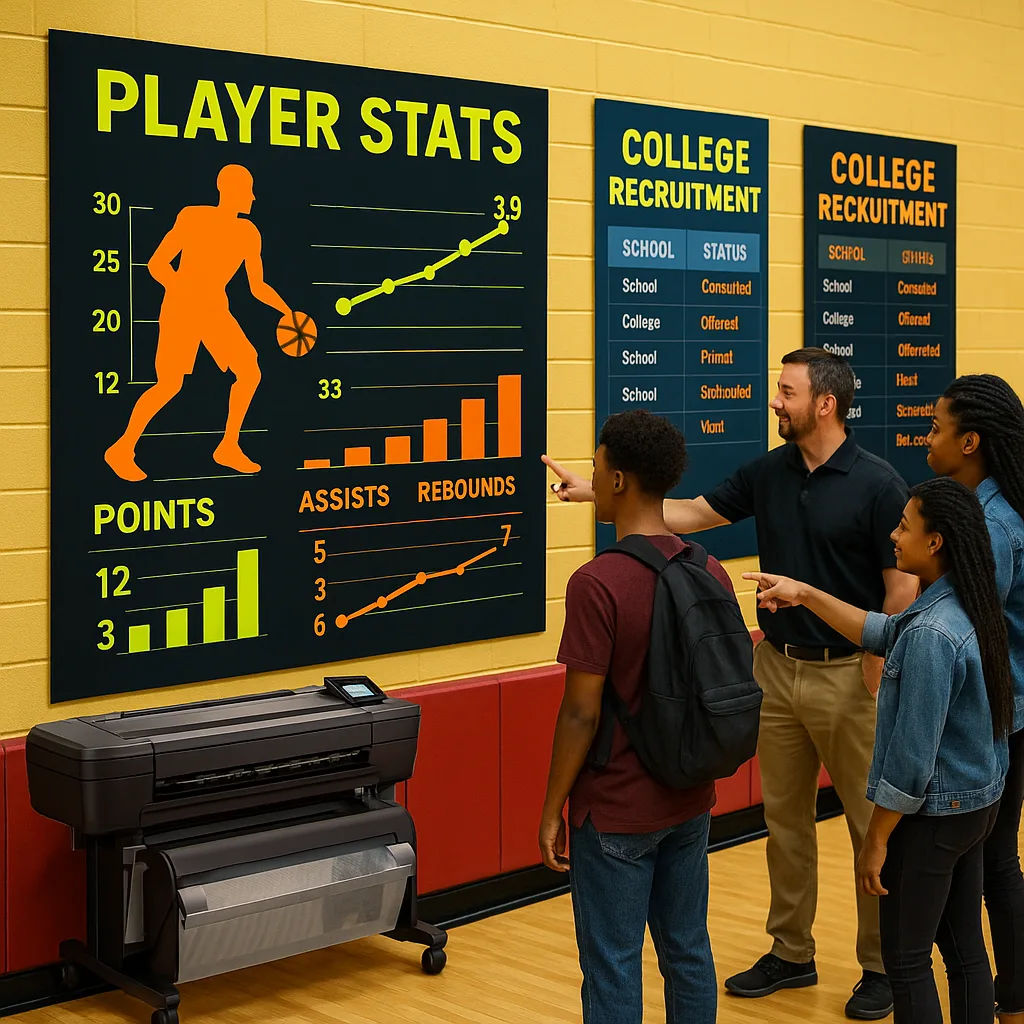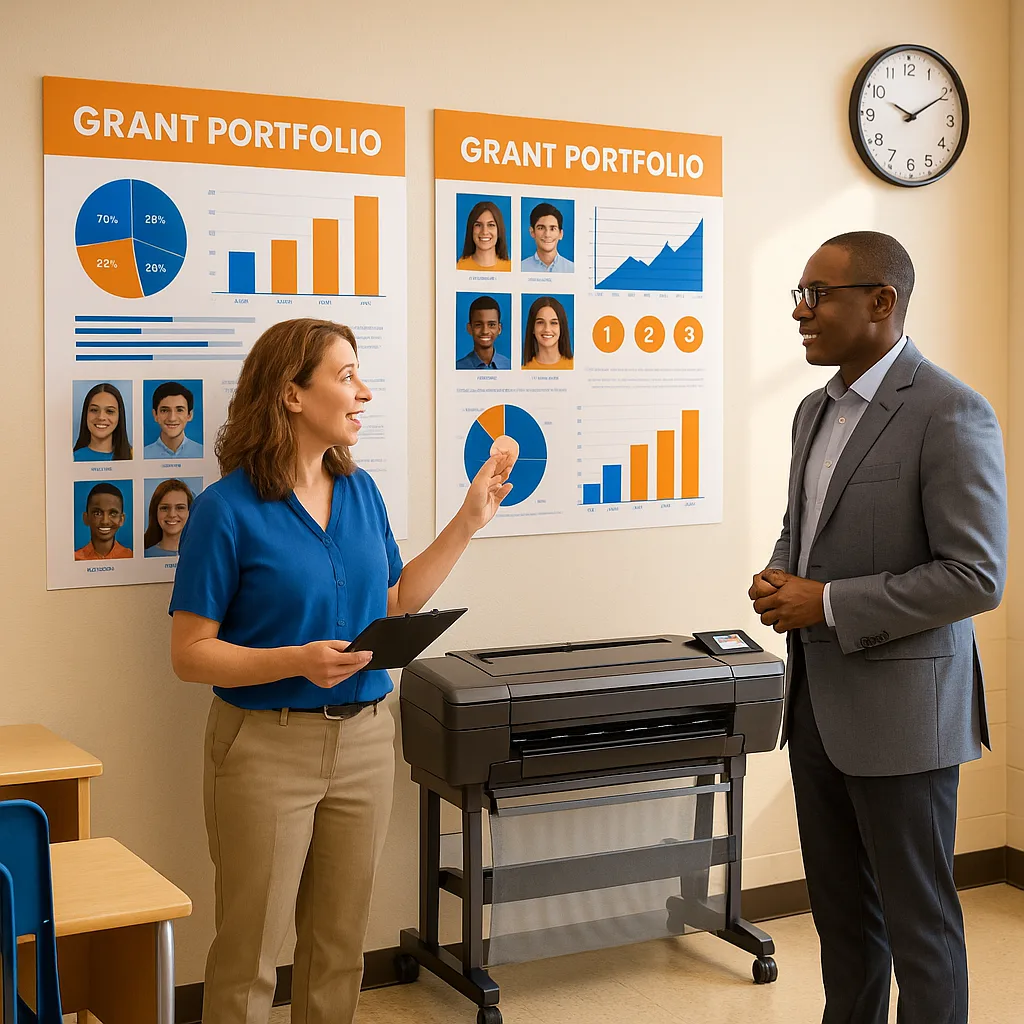
Picture this: Maya’s fourth-grade engineering team spreads their bridge-building journey across the hallway—not just the final masterpiece, but every sketch, failed prototype, and “aha!” moment captured in vivid color. Furthermore, watching students document their thinking process with poster machines project-based learning approaches has completely changed how I view assessment and celebration in my art classroom.
Why Poster Machines Project-Based Learning Changes Everything
Last semester transformed my perspective on PBL documentation. Instead of filing away process work in portfolios, we started creating visual timelines that celebrated every iteration. Moreover, when students see their thinking journey displayed publicly, they develop metacognitive skills that traditional assessments miss entirely.
Students report deeper understanding when documenting process
Parents engage more with visual project documentation
Improvement in presentation confidence with visual aids
The Research Behind Visual Process Documentation
Research from Edutopia shows that students who document their learning process develop stronger reflection skills and retain information 40% longer than those who only present final products. Additionally, visual documentation helps English language learners express complex thinking that might be difficult to articulate verbally.
When schools invest in poster making technology like the Education Express 24″ Package A, they’re not just buying equipment—they’re investing in a documentation system that captures learning as it happens. Therefore, students can print their sketches, failed attempts, and breakthrough moments instantly, creating a visual narrative of growth.
Building Your PBL Documentation Framework
Transform scattered project work into cohesive learning stories that celebrate every step of the journey.
Phase 1: Capturing Initial Ideas and Brainstorms
Every project begins with messy thinking—and that’s exactly what we want to capture! Subsequently, I teach students to photograph their initial sketches, mind maps, and “what if” lists. Using our school’s poster machines, we print these raw ideas at 24″ x 36″ to create what I call “Thinking Walls.”
The magic happens when students realize their rough drafts deserve wall space too. For instance, one team working on sustainable packaging solutions posted every napkin sketch and cafeteria observation. As a result, younger students passing by could see that innovation starts with simple questions and imperfect drawings.

Phase 2: Documenting Iterations and Failures
Here’s where traditional documentation falls short—we rarely celebrate the attempts that didn’t work. However, with instant poster printing, students can create “Failure Galleries” that highlight what they learned from each iteration. Consequently, the classroom culture shifts from hiding mistakes to mining them for insights.
Last month, the robotics club created a timeline poster showing seven different wheel designs that didn’t work. Above each failed prototype, they added sticky notes explaining what they discovered. Meanwhile, other students started visiting this display for inspiration when their own projects hit roadblocks.
Understanding poster making machine price per print helps justify frequent documentation—at roughly $1.30-$1.50 per poster, it’s more affordable than most people realize. Thus, students can document freely without worrying about waste.
Essential Templates for Poster Machines Project-Based Learning
Process Timeline
Visual journey from start to finishHow It Works
Create a horizontal timeline with photo boxes for each major milestone. Include reflection prompts under each image to capture thinking at that moment.Iteration Grid
Compare versions side-by-sideDocument Changes
Design a grid showing each prototype with “What Changed” and “What We Learned” sections. Perfect for engineering and design projects.Reflection Wheel
Capture multiple perspectives360° Thinking
Circular template with sections for initial goals, challenges faced, solutions tried, and future applications. Students fill each section as they progress.Evidence Wall
Showcase skills developedProof of Learning
Template linking project work to specific standards and skills. Include photo evidence with captions explaining the connection.Making Assessment Visible and Meaningful
Traditional rubrics hide in gradebooks, but visual assessment transforms evaluation into celebration. Therefore, I developed “Growth Gallery” posters where students self-assess using color-coded sticky dots. Green means “I’ve got this,” yellow signals “Still practicing,” and orange indicates “Need support.”
Parents love seeing these assessment walls during conferences because they understand immediately where their child excels and where they’re growing. Additionally, students take ownership of their learning when they physically place their progress markers on public displays.
“When students see their thinking journey displayed publicly, they develop metacognitive skills that traditional assessments miss entirely.”
– Ms. Jasmine Park Middle School Art Teacher & PBL Advocate
Presentation Day: Bringing It All Together
The culmination of any PBL experience should feel like an art gallery opening, not a nerve-wracking performance. Subsequently, we transform our multipurpose room into an interactive museum where each project station includes process posters, final products, and QR codes linking to digital portfolios.
Students using poster machines like the Education Studio 36″ Package A+ can create professional-quality displays that rival any conference presentation. Furthermore, the waterproof inks mean outdoor showcases are possible, expanding presentation venues beyond classroom walls.
Presentation Station Essentials:
Digital Integration: QR Codes and Extended Content
While physical posters capture attention, QR codes bridge to deeper digital content. For example, one student’s water filtration project poster included QR codes linking to time-lapse videos of each prototype test. Consequently, viewers could access hours of experimentation in seconds.
Creating these hybrid displays requires understanding both design principles and technical possibilities. Our lifetime design service helps teachers create QR code templates that maintain visual appeal while adding interactive layers.
Real Success Stories from the Field
See how schools transform PBL documentation with visual storytelling
Lincoln Elementary’s Solar Oven Project: Fifth graders documented 12 design iterations over three weeks. Their hallway display showed temperature graphs, material comparisons, and failure analysis. Result? Subsequently, the local environmental club sponsored materials for the entire grade level to build final designs.
Madison Middle’s Community Garden Initiative: Students created a 20-foot timeline showing seasonal progress, pest management strategies, and harvest data. Furthermore, the visual documentation helped secure a $5,000 grant for expansion when board members saw the professional presentation during a site visit.
Getting Started: Your First PBL Documentation Project
Ready to transform your next project? Start small with these manageable steps that build documentation habits gradually.
Week 1: Capture Everything Students photograph or sketch daily. Print one “Thinking of the Day” poster to establish the routine.
Week 2: Organize & Reflect Create categories for documentation. Students select their most important process moments to feature.
Week 3: Design & Display Teams create their showcase posters. Include process, product, and reflection elements.
Budget Considerations: Making Every Print Count
When administrators understand the impact of visual documentation, finding budget becomes easier. Here’s how to maximize your investment:
Understanding poster making machine price structures helps justify the investment. Moreover, when you factor in the educational value of instant documentation, professional presentation skills development, and increased parent engagement, the ROI becomes clear. Schools report that having poster machines transforms not just PBL outcomes but entire school culture around celebrating learning.
Ready to Transform Your PBL Documentation?
Every student deserves to see their learning journey celebrated on the walls. Therefore, start building your visual documentation system today!
Join thousands of educators who’ve discovered the power of visual documentation. Subsequently, watch your students’ confidence soar as their learning journeys become gallery-worthy exhibitions!







